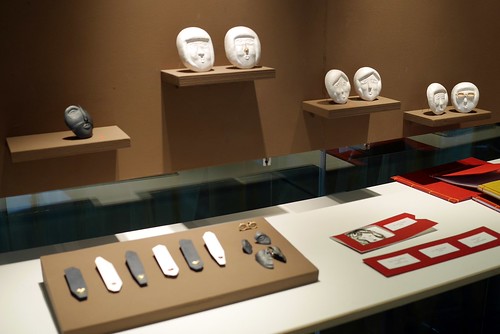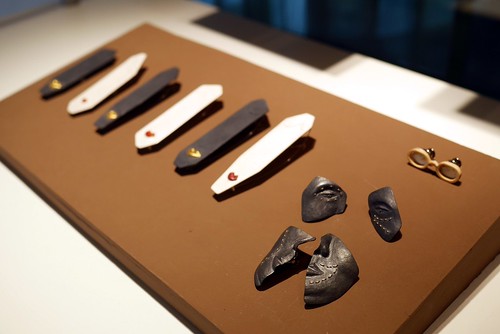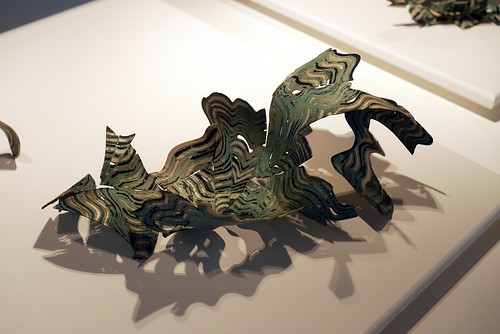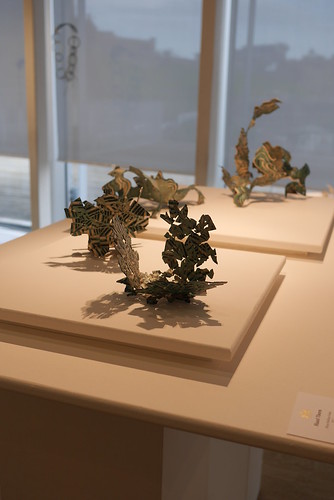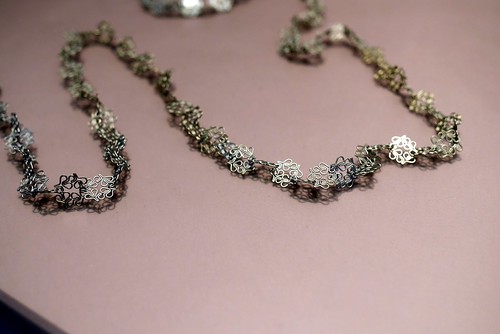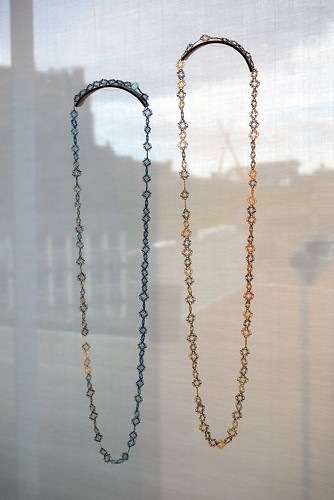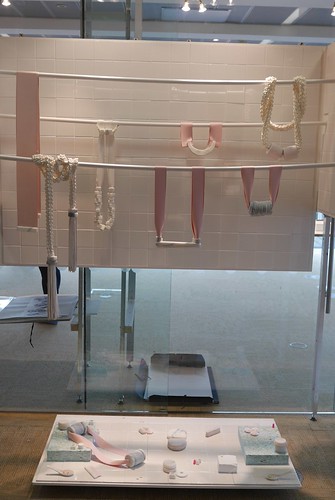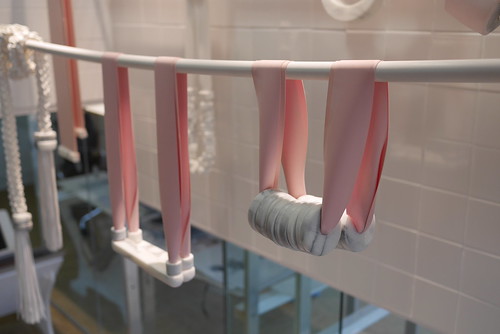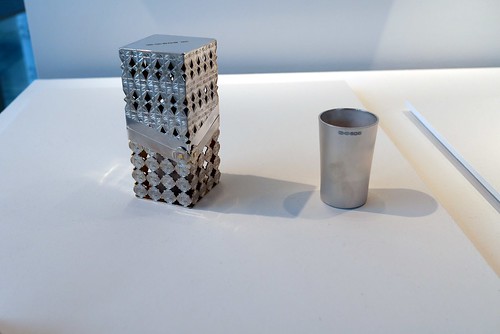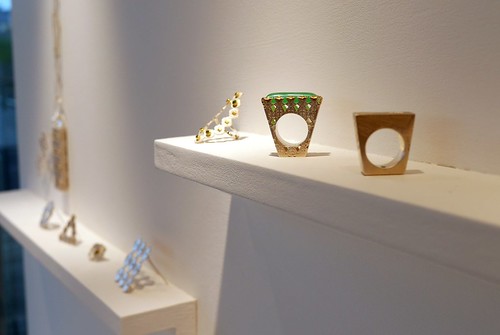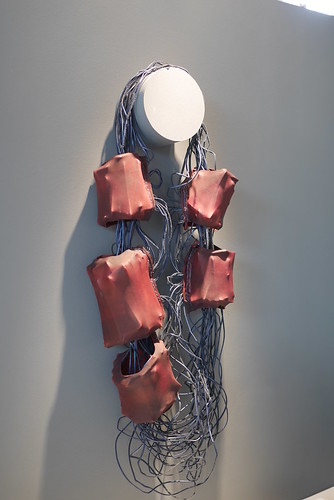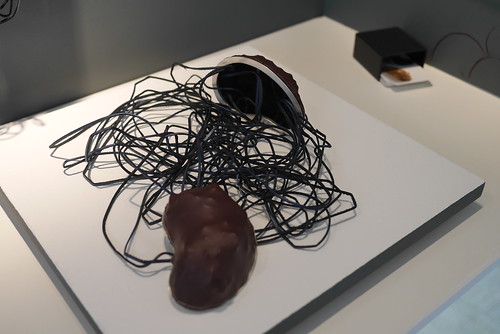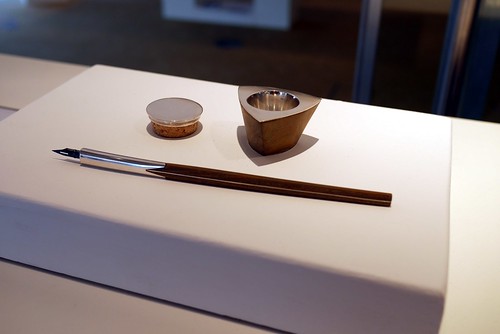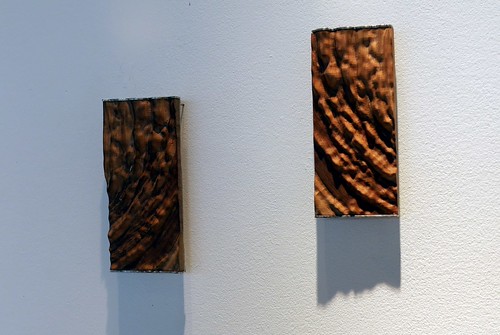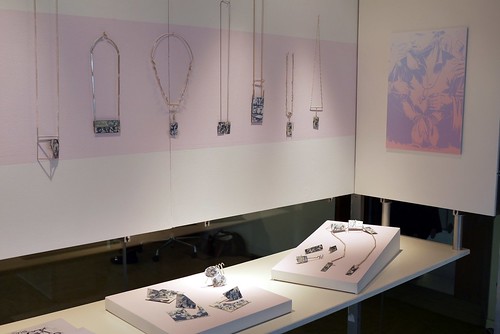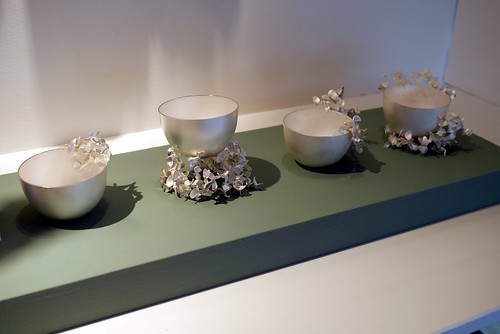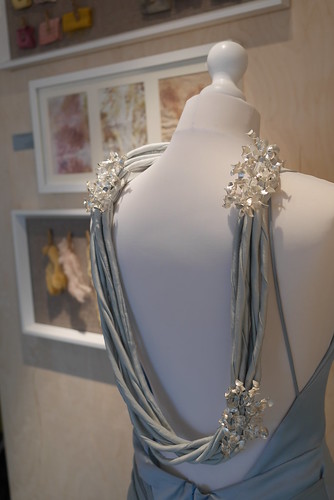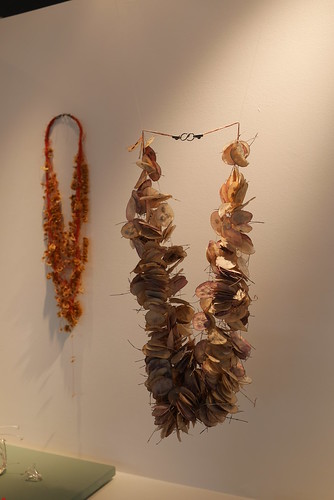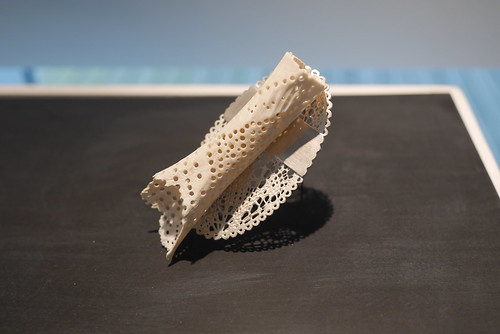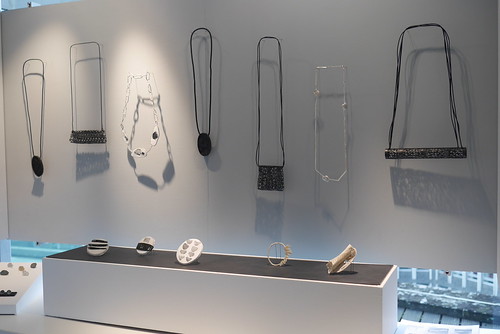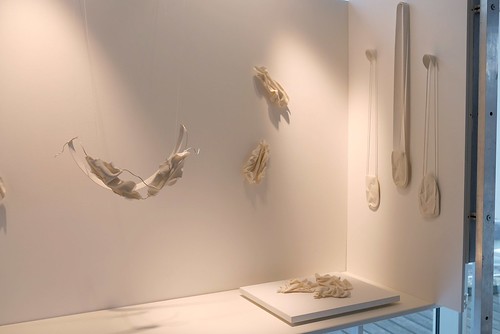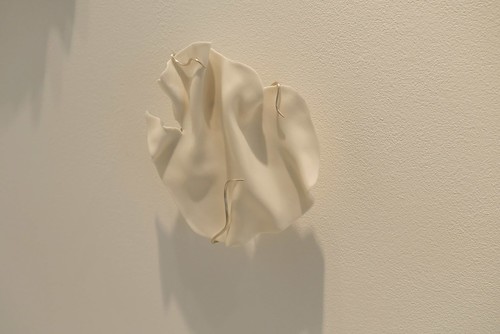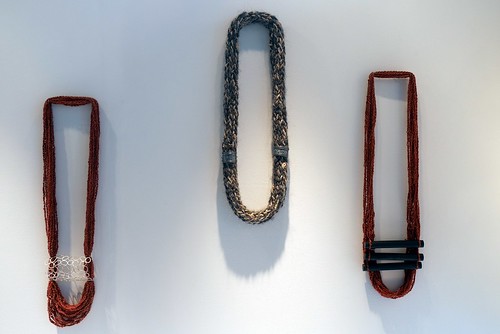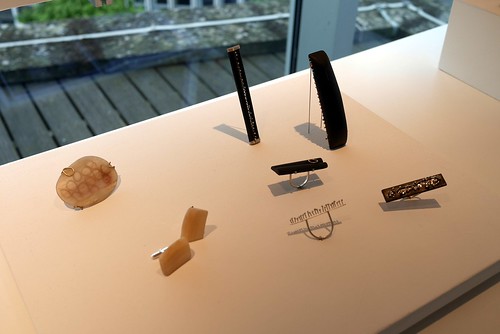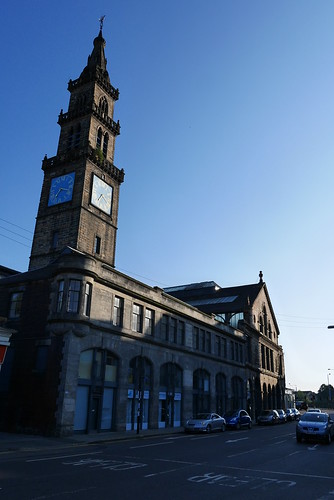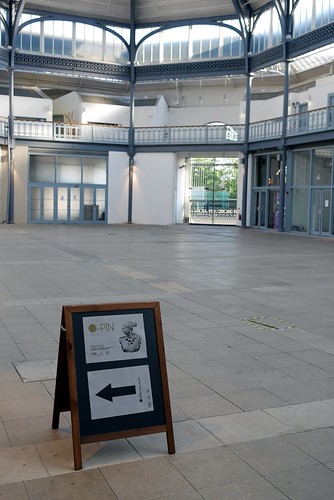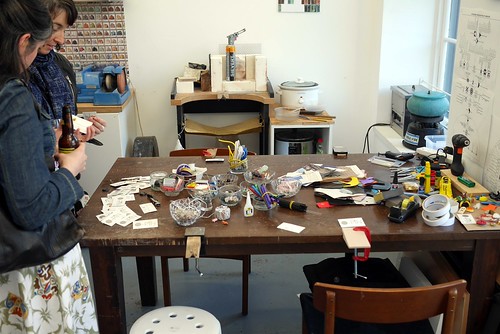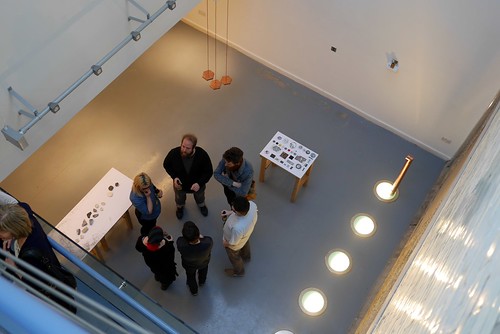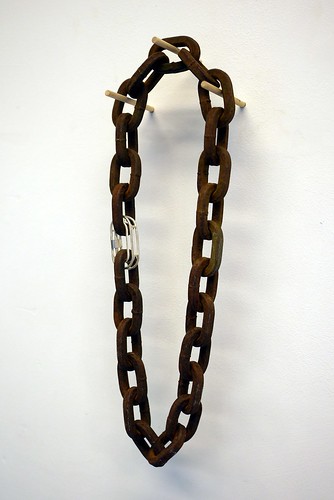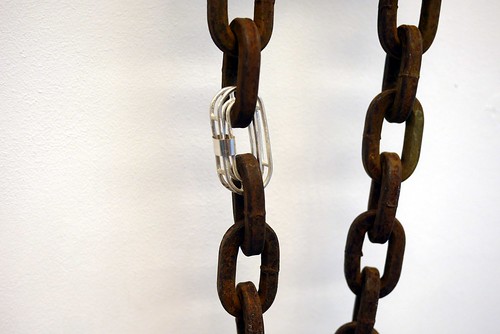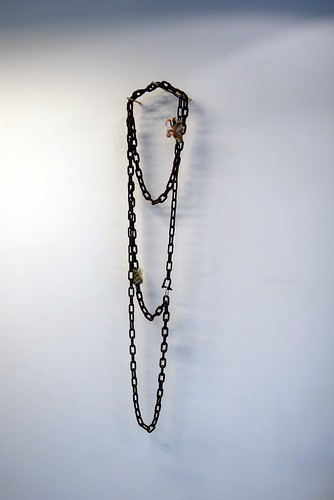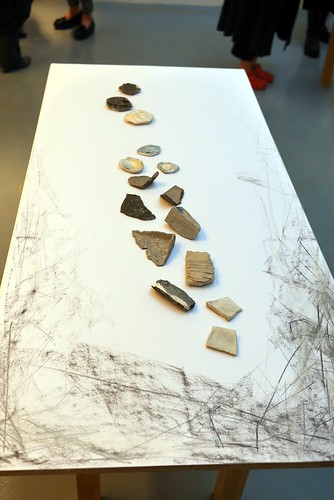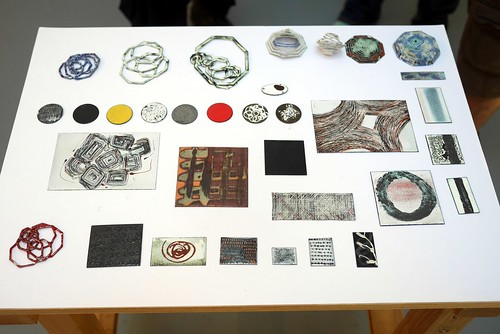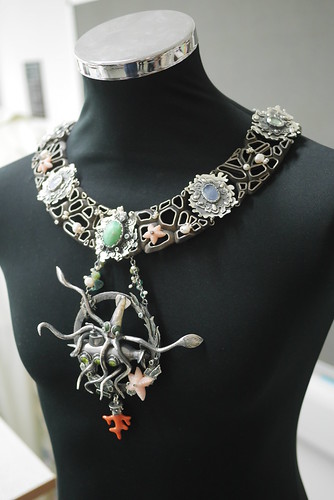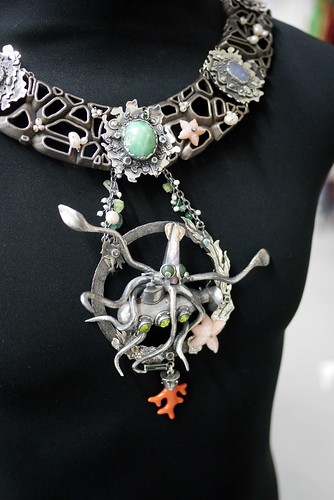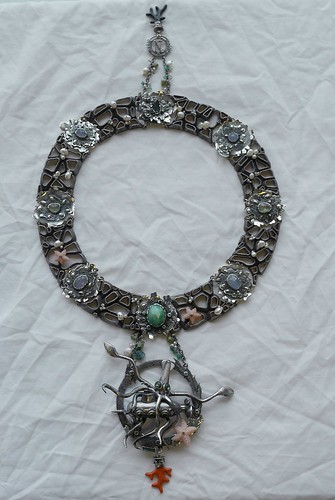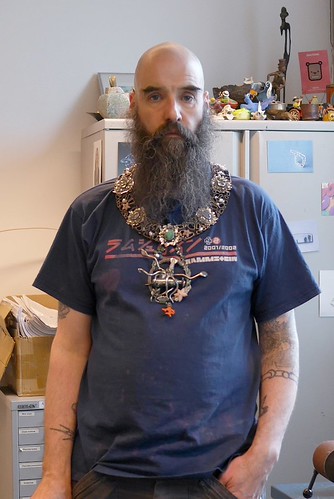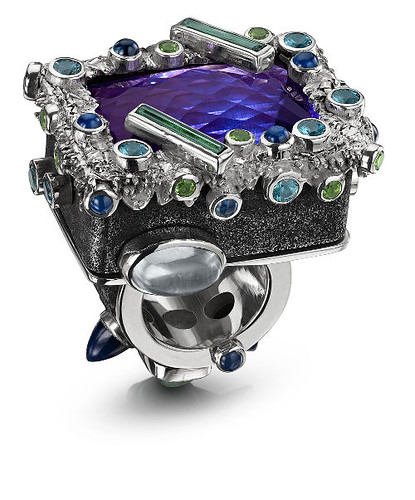It has to be said that the Edinburgh College of Art jewellery degree show is the strongest overall in a long time. There is some absolutely fantastic work there and Edinburgh is a bit different from other colleges in that it presents the work by the MFA students at the same time as the work by the BA students.
The first work I came to was by one of the MFA student, Yu Hsiang Liao, who has been exploring ideas of "beauty" and cosmetic surgeries. I found this work remarkable for the way that it combined humour with something as challenging as the "beauty myth":
Hazel Thorn's fragmentary vessels are remarkable works in fused and patinated metals of various forms. I can't think that I've seen anyone else working with patinated metals in quite the same way and the evenness and clarity of her colours perfectly contrast with the fragmented forms which she then creates:
Karen Elizabeth Donovan's chains in titanium and precious metal wires are a delight. They reminded me of nothing less than the incredible chains found in the Cheapside Hoard, which I saw in London last year. I'm pleased to see that titanium has reappeared as a metal in jewellery - I know that for people like Lynne Bartlett, it has never gone away - but I feel as if the metal has been neglected by the art schools for too long, perhaps never even recovering from its hideous misappropriation in awful 1980s works... Anyway, Karen's chains are far from that, being subtle and intricate:
I will confess to not really understanding Isla Macer Law's exhibition of jewellery in rubber and marble. The pieces begged to be touched and played with but there is also something repellent about the pink rubber which supports them. Perhaps that reflects more on my own unhappy relationship with the colour pink than on the work itself! The tension between touch/don't touch also played out in a fear of contaminating the purity of the white stone and clean rubber surfaces. I would really like to see these pieces worn:
One of the things most notable in this year's show is the level of hand-skills displayed by many of the students and Joseph Alessander Metcalfe is plainly a finely-trained jeweller/silversmith who has built up a portfolio of design skills. Every single piece on his stand showed a control, restraint and mastery:
Agne Visniauskaite's pods were the only work that did not immediately appeal to me but she had laid out samples under her stand which could be touched and explored and this allowed me to appreciate the tactile qualities of the work (as I have said before, I really appreciate degree shows with research samples presented alongside the finished works). She works in leather and metals and while I can appreciate the work in a very pure sense, I found the forms and colours to be quite off-putting: perhaps that was the point.
Another of the makers who plainly has a well-developed classical jewellery skillset is Patrick Hoye, who has been working very finely in silver and wood, making not only jewellery but objets de vertu as well, pieces such as this pen and ink-holder:
And a pair of matched, mirror-image brooches in olive wood and silver:
Without any exception, my favourite concept in the show is Jospehine Conkie's remarkable fusion of jewellery and storytelling, taking the concept of narrative jewellery in a direction I have played with (in "The Mysterious Adventure of Lady Stevens") but which she has followed through to a satisfying and complete end. Her "Last Hours Collection" is a series of exquisitely painted, enamelled jewellery made to reflect scenes from her own short-story collection, "The Last Hours", which will be published soon. (My one criticism of the collection would be that there were no copies for sale: I would have bought one if there had been.) The quality of every aspect of this collection is superb.
Jessica Dickson's presentation was interesting in that she bridged a lot of disciplines in her practice, covering botany, dying, dressmaking and some very fine silversmithing, yet managing, somehow, to keep the whole presentation feeling satisfying and complete. Not an easy task. Starting with the plant forms, especially the seed-dispersal mechanisms, she tries to capture what she refers to as the "Genius loci" of a place.
Lyndsay Cheyne created my favourite single piece of the whole show:
She has been exploring "Shetland lace" - a material of which I had been hitherto unaware - as well as the structure of bones and much of her work is material-led:
I always think that porcelain is sadly underrated as a jewellery material and I am very fond of pure white, unglazed porcelain, which is much tougher than it looks. Hannah Leigh has been working exclusively in porcelain and silver to great effect with her contemplative, minimalist pieces which seem to reference Alison Watt's Shift paintings:
The last exhibit I came to was Terri Cambpell's work in silver, wool, horn and other materials which reflect her background in farming in the south-west of Scotland. It is really interesting to see how many of the other students were also influenced by the Scottish landscape and it is always great to see the different approaches that they take to conveying this. Terri's work is not only ultra-modern and well-crafted but sits very comfortably in the much more traditional world of weaving and tweeds; this is fresh work which manages to be quintessentially Scottish whilst avoiding the manifest pitfalls facing makers who want to take such an approach:
As ever, ECA have produced an excellent webpage giving the details of each student and the contact details for them.
Next up was the opening of the newest jewellery space in Glasgow in "The Briggait". The Briggait is Glasgow's old fish-market and is an amazing building:
For many years, Glasgow City Council has struggled to find a use for this building. It is a bit out-of-the-way - though still very central - and has never really been used in any sort of satisfactory or long-lasting way. It was recently bought by the excellent artists' charity, WASPS (which does not relate to skin colour or faith!) and converted beautifully into studio, exhibition and performance spaces, with studios available at affordable rents.
At last year's GSA degree show, I was very taken with the "O-Pin" project. Some of the people involved in that have now taken space in The Briggait and Friday night saw the opening of the space with an exhibition of work by people in the collective.
The studios are really bright and airy and this is only one of several jewellers who have taken studios in the building:
The photograph above shows Stefanie Cheong's "O-Pin" project transferred to the studios here. The gallery space is small but is at the core of the complex:
It was good to catch up with the work which I saw last year, especially the new pieces by Amanda McQuat, made from my own favourite materials, rusty iron and silver:
Rhona McCallum was also showing - her work was also in the AIR "16" show last week at The Lighthouse - with new work in pewter, silver and stone:
Scarlett Cohen-French has continued to make her lovely enamels and has developed a lot of the texturing and mark-making techniques she exhibited in her degree show:
I really hope that The Briggait in general and this collective in particular make a go of this. It is time Glasgow had a contemporary jewellery hub.
Which brings me onto my own work and my "20000 Leagues Under The Seas" collar, which I finished this week. I am going to immodestly state that I think that this is one of the finest pieces I have made and that I'm really pleased with the way it turned out:
Although it looks oversized, it is actually surprisingly comfortable to wear:
It sits very neatly on the shoulders.
My favourite part of this is actually the propeller on the submarine, which was designed to a tutorial I found online about how to design real propellers using Rhino (which was developed as a boat-building software anyway):
I'll be sending this off to Andrew Neilson for photography soon.
On that subject, I'll finish with the shot he took of my post-apocalyptic cocktail ring, "(It's The Time) Of April Snows":

